The boat just kept coming. We watched from the sand, where we had safely anchored off, as the shallow water boat made a steady clip toward the submerged end of the same bar. We waited for the driver to slow down, but he didn’t, slamming his bow into the bar and coming to an abrupt halt. We walked down the sand to say hi, knowing he’d have some time to kill before high tide.
This newly beached boater obviously didn’t have a chart. But there are things you can do beyond relying on your electronics and setting a course. Use your senses to avoid treacherous water, and if you still get caught, there are some maneuvering tactics for working your way out of danger.
Our stranded friend? A few visual cues (including the fact that we were walking yards away from where he ran aground) should have clued him into the fact that he was running shallow. Not sure what he should have seen or done? Read through these cruising tips for shallow water boats to make sure you don’t end up beached.

Tactic 1
Reading Water
Watch for wind ripples, breaking waves or current edges to indicate a transition to shallow water.
Sometimes you’ll be able to follow a close-knit assemblage of channel markers to keep safely inside a channel. Sometimes you won’t. And charts may show outdated information due to shifting sandbars or recent weather events. But your eyes can help.
First, scan the water for color changes. In clear water, the deeper channel should be apparent compared with the flats, sometimes a darker color due to rocks or grass beds or mud flats; sometimes lighter due to pure sand. But in murky water it can all look the same. Watch for wind ripples, breaking waves and current edges that indicate a transition to shallow water. Keep an eye on the depth sounder. A gradual drop in depth could precede a quick jump to shallow water. Watch for drops, and slow down while you’re still deep enough to assess your surroundings. If you boat in skinny water areas, side-scanning sonar, which assesses the depth around the boat as well as underneath, is a great investment.
Color Coded
1. Clear water shows the channel.
2. Dark water shows shallower areas covered in turtle grass.
3. Wind ripples can show skinny water.
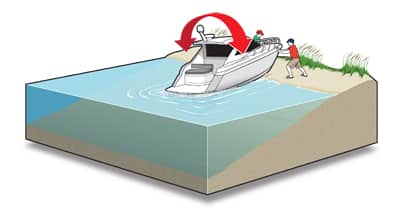
Tactic 2
Rocking and Rolling
When you’re really grounded, get out of the shallow water boat and use manpower to rock it unstuck.
The boater who slammed into the sandbar at 30 mph tried to correct the situation by gunning his engine in reverse, throwing sand and water into the air, redlining his engine and generally making the situation worse (and stuffing his water pump with sand, which probably led to an overheated engine and maybe a cracked block). The first thing to do should you run aground is turn off the engine and check it and the hull for any structural damage. Remember it’s better to be aground than sunk. If everything’s OK, and no water is coming in, you may be able to work the throttle to back off. But if you’re stuck fast, you’ll need an assist.
Offload and rock the boat from side to side. This cants the deeper V section and reduces the draft. As the keel gets free of the bottom, you may be able to push the boat. As the keel drops, it might stick again. Keep rocking and pushing until you get into deep enough water.
If there is wind blowing or current running in a favorable direction (toward deep water), you can often accomplish this without getting out of the shallow water boat. Have your crew move as a group from side to side, which will lift the keel. As it lifts, the boat will move downwind or downcurrent. Again, make sure the hull, fittings and drive mounts weren’t breached. When you get home take a closer look.
Side to Side
1. From inside the boat, have the crew shift the craft from side to side to lift the keel.
2. Gently work the throttle in reverse to help the boat become unstuck.
3. If you have to, unload the crew and some heavy gear.
4. Have the crew rock the boat from side to side.
5. If the keel rocks free, you may be able to push the boat to deeper water without a power boost.
Tactic 3
Listing
So you veered off course and need to get back to the channel. Listing the boat to one side can help. If you can’t trim the drive up any farther, try making sweeping turns back and forth in an S pattern. This will kick the angle of the drive to the side, bringing it up an inch or two farther from the bottom.
Listing also moves the centerline, typically the deepest part of the boat, to one side so that it doesn’t run as deep. Use the tabs to create an extreme list and run on a hard chine, a rough-water trick that also works in shallow water for boats with deeper V’s, since the chine will run shallower than the centerline.
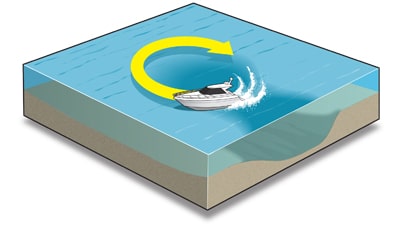
Tactic 4
Circle Start
Backcountry flats guides have perfected this technique. They find a pothole or deeper stretch of water, trim down the tabs and gun the throttle while turning hard over. This brings the boat on plane “on edge,” canting the drive at an angle and decreasing draft as it doubles back into the deep water. After doing this, run the prop and drive in enough depth until the boat planes. This can work for your boat if you find a big enough pothole. Deploy the trim tabs to keep the bow down and set the wheel before you start, so that your boat quickly turns back into the deep water.
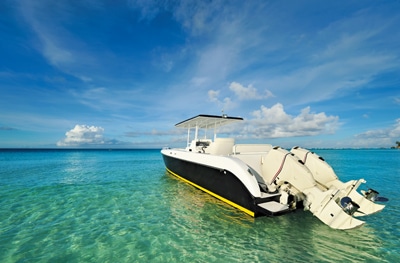
Tactic 5
Trimming Up the Engines
Sometimes the right thing to do is as simple as trimming the engines out of the water and letting your boat float off.
Pretty obvious, right? You get caught in shallow water, and the first thing you do is trim up the engine or engines as far as you can. (Pod-drive and inboard owners can move on to the next topic.) That makes sense to a point. You don’t want to trim the drive up on takeoff or the boat will experience exaggerated bow rise climbing onto plane, digging a deeper hole. Trimming too high will also reduce steerage. Sometimes you have no choice; we’ve all seen the boats at idle speed puttering off a flat throwing a rooster tail from the exposed prop.
Other times, the drive acts as an anchor. Have you ever seen a flats guide trim his engine down to stick the skeg in the sand for a quick stop? On the flip side, the way to get unstuck can be as easy as trimming the drives as far out of the water as possible. Look at the draft numbers on many boats. With the drive down, a typical 25-footer will have a draft around three feet. Trim the drive up and the draft could shrink by a foot or more. With luck, the wind and current will help you drift to deeper water.
High & Dry
1. Trim the engines as far as you can out of the water to increase draft.
2. Shift gear and crew to the bow to offset engine weight, raising the transom a little higher in the water.
3. Wind and current may do the rest.
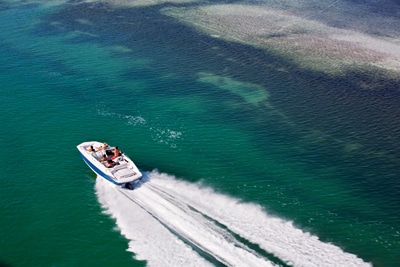
Tactic 6
Staying on Plane
When you’re caught in shallow water, the best thing to do can be to keep going and stay on plane, until you reach deeper water.
Sometimes if you find yourself running through water that seems too shallow for your boat, the best thing to do is keep going. When your boat is on plane, it is riding on the V toward the transom, and the prop and drive are elevated. When a boat falls off plane, the forefoot now comes into play and the boat’s full displacement takes effect, meaning it will sit deeper in the water. Also, increased lift occurs in water depth equal to your boat’s draft. You can feel the boat “rise” as you head over the shoal. However, this is a tactic best used when you know the water, not in an unfamiliar area.
Even if you keep the shallow water boat on plane, your first instinct may be to slow down. But sometimes, it pays off to go faster. Take a look at how a bass boat flies on plane. At high speeds it’s running on nothing but a small delta pad and almost the entire drive is out of the water — everything but the prop. Conversely, riding at slower speeds tends to make your boat squat, digging deeper in the water. The higher your bow is riding, the deeper the stern.
Going fast can get you into trouble, like with the speedster we saw slam the sandbar, but if you know the water’s deep enough to stay on plane and you have a clear path back to the channel, keeping your speed could be the key to escape.
Run & Gun
1. Maintain your speed to keep the hull and drives as high in the water as possible.
2. Trim the engines to the boat’s performance sweet spot to help the hull release.
3. Running on plane in shallow water increases your boat’s lift, decreasing draft for running.
Tactic 7
Tabbing Down
Most people associate trim tabs with improving a boat’s ride in rough seas or correcting a list, but they’re also great tools for shallow water situations. When climbing onto plane, dropping the tabs pulls the bow down to plow through the hump rather than climb over it, so the boat keeps a more level attitude. It’s less efficient but it will keep your skeg and prop a few extra inches off the bottom.
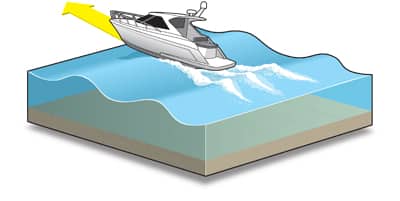
Tactic 8
Riding the Crests
Rough conditions in skinny water can be more dangerous than big seas outside the inlet. Why? Large waves running through a shallow area leave almost no water depth in the troughs. If you ride the waves wrong you can slam the bow, keel or engine into the bottom with enough force to break something. Time your run to ride on the backs of cresting waves. Look for an opportunity to ride across a crest to deeper water, using some of the water-reading tactics above, your local knowledge or a chart.
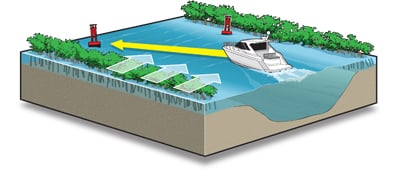
Tactic 9
Reading Wind and Current
Learn how natural forces affect your course and how to adjust at the helm.
Yeah, eyeballing wind and current will reveal those shallow areas, but it’s also important to understand how these forces affect your course. That they will move your boat is a given. On every test we do for this magazine, we run speed numbers both into the wind or current, and with them. On a honking tide or with a stiff breeze, the speed over ground can swing as much as 5 mph. Imagine that force pushing against the beam of your boat. (Or, think about how a stiff wind catches your car on a bridge.)
This comes into play when running a channel between markers. You may think you’re lined up with the next marker, but a crosscurrent or wind can push you out of the channel and into danger. Overcome this by pointing to the marker on the opposite side, or constantly correcting into the wind or current from the helm.
In extreme cases, remember that wind and current can push water in a certain direction. A strong blow can stack water against the windward side of an island or land mass. Sometimes there will be a few extra inches, or even feet, of depth where water is forced against an impassable barrier.
Correct Your Course
1. Know that wind and current can push your shallow water boat off course.
2. Adjust your course into the wind or current and apply constant correction at the wheel. Pick a landmark or marker to windward.
3. Pay attention to how the wind is pushing water. In extreme cases, it can stack water against the windward side of a land mass or structure, creating a few extra inches — or even feet — of depth.









